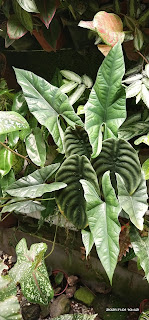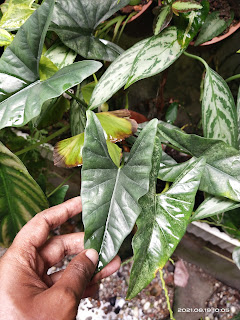INTRODUCTION:
Alocasia Simpo appears to be very much like any other ordinary Elephant Ear Plant - however it is often sold in the "rare" "Jewel" Alocasia category. Often you will find them sold in a seedling where the foliage appear to be in a circular formation where the sinus is not divided.
Only once its in a mature form - it have more detailed features, here you can see, it appears to have a stronger appearance where it is hardy exposed to rain and sun - the leaves however have a beautiful green & blue tones. It does appear to have few mix characteristics with some of the Jewel Alocasias namely like the Alocasia Sinuata where the veining and coloration are very much similar.
There are not much of botanic information concerning research or any opinions based on any growers or gardeners concerning this Alocasia Simpo. Somehow it brings to consider that it could just be a marketing gimmick to rename or re-label an existing Alocasia plant by most plant vendors.
In fact, Alocasia Lukiwan appears to have very strong similar characteristics with Alocasia Simpo which bring me think that the the factor of ID can be very challenging when the true name of the plant are not been properly identified when used by plant vendors.
However based on the pictures viewed - Alocasia Lukiwan does look much wider in comparison to Alocasia Simpo. I hope more accurate and proper research are available for me to make any comments on these - as for now, I hope the pictures do justice for identification.
CHARACTERISTICS:
Apart from the foliage characteristics, I can say that this particular one is very hardy and easy to grow - almost like any Big leaved Elephant Ears Type of Plants. However it is also not immune to spidermite infestation hence routine check is necessary to make sure no major damage takes place.
I had faced a horrible spidermite infection where I placed this in the indoor condition away from rain and shine - the damage was permanent and you might not even know whether they are still infected or wipe-out with the current damaged plant. The first thing is that you would be tempted to trim off all the plants and hope for the new leaves to emerge without any damage - however you will be totally risking the whole plant as it can go into shock and the plant can rot and die.
(This happened to almost 90% of my collection) The surviving ones took almost 6 months to recover, others though was considered an unfortunate reality. A hard and difficult lesson to learn, hence forth - I always check and quarantine my new bought or introduced plant and apply a good measure of pesticide / miticide to protect my current collection.
WATERING / MEDIUM / FERTILIZER
I do daily watering for this one using coco-chip and sand for potting mix and weekly application of foliar fertilizer for this plant. Normally - I would apply foliar fertilizer for all my garden plants and these get included in the weekly regiment.
Apart from this, I think everything else is very much the same basic care and maintenance of the plant.
(spidermite infected leaves)
(comparison of the new leaf with the old infected leaf - bottom)
To check on the Main Page Concerning Different Types of Jewel Alocasia:


























No comments:
Post a Comment